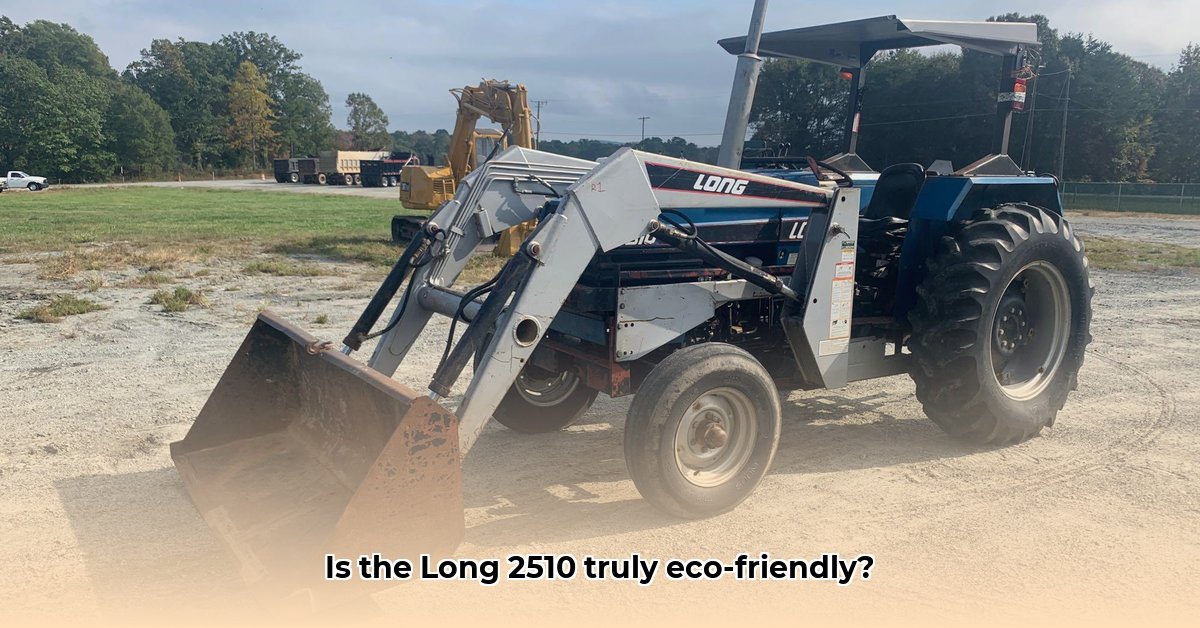
A Sustainable Choice for the Modern Farm?
The Long 2510 tractor, a product of the 1990s, presents a compelling yet complex question for today's environmentally conscious farmer: can a vintage machine truly contribute to sustainable agriculture? This article delves into the Long 2510's capabilities and limitations, exploring its historical context, technical specifications, and its potential (and challenges) in modern sustainable farming practices. We'll examine its suitability for small farms, analyze the sustainability implications, and offer actionable advice for farmers, researchers, and policymakers. But first, can a tractor designed decades ago truly compete with modern technology in a sustainable agriculture context? For cost comparisons with modern tractors, see tractor costs.
Technical Specifications and Historical Overview: A Look Back
The Long 2510, produced between 1990 and 1997, was a compact tractor boasting a 54.6 horsepower engine and a 49.1 horsepower power take-off (PTO). Its 16.4-gallon fuel tank and 5.25-gallon hydraulic system offered decent capacity for its time. While reliable and versatile for a range of farm tasks, its technology is significantly outdated compared to modern tractors. This historical context is crucial for understanding its relevance to modern sustainable agriculture.
Sustainability Analysis: Weighing the Pros and Cons
Modern sustainable agriculture prioritizes efficiency and minimizing environmental impact. Does the Long 2510 meet these criteria? Its age poses a significant challenge. Unlike modern tractors, it lacks advanced fuel-saving technologies and precision guidance systems, leading to higher fuel consumption which consequently increases greenhouse gas emissions. While its fuel efficiency was likely good for its era, a direct comparison to contemporary models is necessary for a comprehensive assessment. Furthermore, data regarding its overall greenhouse gas emissions and long-term maintenance costs is currently lacking, representing a significant knowledge gap. This lack of comprehensive data makes it difficult to definitively assess its true environmental footprint.
"The absence of precise data on fuel efficiency and emissions represents a major hurdle in evaluating the Long 2510's sustainability," states Dr. Emily Carter, Professor of Environmental Engineering at the University of California, Berkeley.
Filling the Knowledge Gap: Research Priorities
Further research is critically needed to assess the Long 2510's true environmental impact. This includes detailed studies on fuel consumption rates, emissions (both direct and indirect), and long-term maintenance costs comparing it to modern alternatives under real-world operating conditions. These studies should also consider factors like soil compaction and overall productivity to create a comprehensive picture. Without this data, its role in sustainable agricultural practices remains uncertain.
"Comparative field tests against modern compact tractors are urgently needed to objectively assess the Long 2510's sustainability," adds Dr. Carter. "This includes measuring fuel efficiency per acre, soil compaction levels, and overall productivity."
Practical Applications: Niche Uses and Considerations
Despite its age, the Long 2510 might find a niche in specific farming contexts. Smaller farms or those with specialized needs, such as orchards or vineyards, might benefit from its maneuverability and manageable power output. However, farmers must consider potential repair costs and parts availability. Sourcing parts for an older machine can be expensive and time-consuming, which undermines the overall sustainability.
Actionable Recommendations: A Multi-Stakeholder Approach
To effectively evaluate and utilize the Long 2510 responsibly, a multi-pronged approach is crucial:
Small-Scale Farmers: Carefully weigh the initial cost against potential long-term repair costs and fuel consumption before purchasing. Prioritize preventative maintenance to extend the tractor's lifespan and reduce environmental impact.
Researchers: Fund and conduct comprehensive studies comparing the Long 2510's environmental impact to that of modern tractors. Focus on fuel efficiency, emissions, and lifecycle analysis.
Equipment Manufacturers: Explore manufacturing and supplying replacement parts for older, yet functional tractors to promote repair rather than replacement, extending the lifespan of existing machinery.
Policymakers: Implement policies that encourage responsible disposal of obsolete equipment and provide incentives for sustainable equipment upgrades and refurbishment.
Conclusion: Context Matters
The Long 2510 tractor, while historically significant, presents a complex sustainability challenge. While it might be suitable for certain niche applications on smaller farms, the lack of comprehensive data obscures its true environmental impact. This case underscores the urgent need for thorough research and a holistic approach to sustainable agricultural practices - considering not only the initial purchase but also the entire lifecycle of farm equipment. The Long 2510's legacy serves as a reminder of the ongoing need for innovation and data-driven decision-making in the agricultural sector.